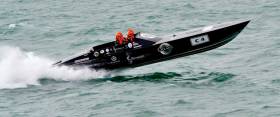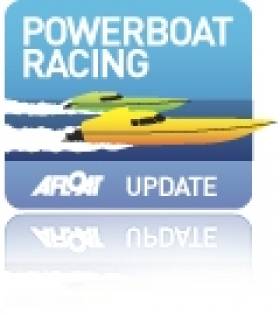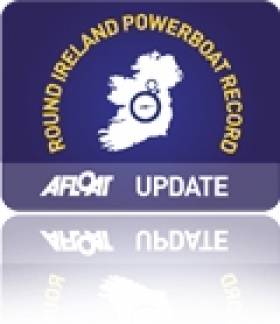Displaying items by tag: powerboats
#Powerboats - An Irish-based powerboat racing team is aiming for a full 11 offshore endurance and speed records over the next three years.
“It’s ambitious, but it’s do-able,” as Red Bull hears from John Ryan, team driver and throttle man with Allblack Racing and an Afloat.ie Sailor of the Month in his own right for Team Hibernia’s record-smashing Round Ireland powerboat run.
The 11 challenges of the Union International Motonautique (UIM) offshore ocean endurance long distance and speed records represent a step beyond for Ryan and his team mates.
Allblack Racing will take to Irish waters again for the Cork-Fastnet loop and the Round Britain and Ireland challenge, as well as the Round Anglesey run in the Irish Sea and Menai Strait.
The team will also tackle various taxing European routes such as an Italian speed trial from Naples to Capri, a blast between the Channel Islands and the Isle of Wight, and a straight 60-hour run from London to Monte Carlo.
That’s not to mention the epic routes from London to St Petersburg and Miami to New York that will complete the list — all raced on the team’s Swedish-designed Allblack SL44 that's been specially adapted for extreme racing.
Allblack from Konjow Films on Vimeo.
What’s more, there’s an opportunity for additional passengers to join Ryan and his team mates Philip Fitzgibbon and Ant Middleton — if you can bring funding for the demands of each record, you could get trained up and listed as co-driver for the fourth seat on the boat.
Red Bull has much more on the story HERE.
Galway Hosts In-Port Races As Powerboating's Venture Cup Returns in 2016
#Powerboats - The Venture Cup for powerboat racers headlines a "bumper calendar of events" in Galway Harbour next June, as the Connacht Tribune reports.
Galway will be the only in-port race stop on the 1,000 mile challenge, reportedly "the longest, toughest and most prestigious powerboat race in the world".
And what in-port racing that will be, as up to 25 of the world's very best powerboat racers will blitz past Salthill Promenade towards the Atlantic from 16 June at such speeds that they'll be using the Aran Islands "as a chicane".
Not only that, but the celebrity involvement is sure to bring out the crowds to Galway and ports clockwise around Ireland from Cork to Dublin.
TV adventurer Bear Grylls is believed to have booked a berth on board one of the super-speed boats that can go as fast as 240mph, while Ireland will be represented by the youngest competitor, 18-year-old Adam Brennan – son of hotelier and host of RTÉ TV's At Your Service, John Brennan.
The Connacht Tribune has more on the story HERE.
Galway Sea Scouts Repeat Success In ISA Powerboat Challenge
#Powerboats - The 24th Galway Sea Scouts made it two in a row when they came out tops in the ISA Powerboat Challenge for the second year running last weekend.
The winning team - consisting of Fionn Delahunty, Ciaran Jordan, Eamonn Murphy and Róisín Jordan, with manager Alan Delahunty and coaches Caran Oliver and Graham Daly - faced an ever tougher challenge at this year's event held in Galway Bay and around Galway Docks on Saturday 19 October.
They fended off strong competition from Galway City Sailing Club and Bellacragher Boat Club to take this year's title across a series of water exercises that included rescuing capsized dinghies and canoes, and lee shore rescues.
But Galway City didn't leave the challenge empty handed, as team member James Rattigan took the new award for 'best helm' at the evening's presentations at the Galway Harbour Hotel.
Largest Vessel Transits Samuel Beckett Swing-Bridge
She remained alongside this berth which is normally used by large commercial ships until the vessel sought a berth much closer to the city-centre. This led to a shift of berths in the evening when the 2003 built vessel headed upriver to the Dublin City Moorings facility at Custom House Quay, but this firstly required transiting through two bridges.
With a beam of 10.6m Fortunate Sun entered through the East-Link toll-lift bridge followed by the Samuel Beckett bridge, the Liffey's newest crossing point which opened in late 2009. The €60m bridge was commissioned by Dublin City Council and designed by the Spanish architect engineer Santiago Calatrava. To read more on the bridge click HERE.
Fortunate Sun is registered in the Caymen Islands and is capable of over 17 knots on a range of 5000 nautical miles. She has a steel hull and an aluminium superstructure and interiors also by Tim Heywood Design. In the early hours of tomorrow morning the vessel built by Oceanfast is to depart through the 5,700 tonnes bridge which was delivered by barge after a five-day voyage from Rotterdam.
There has been previous transits of the bridge notably the annual Dublin Rally organised by the the Inland Waterways Association of Ireland (IWAI). This year's Dublin Rally took place on 1 May when boats travelling on the Royal Canal descended via Croke Park and entered the Liffey at Spencer Dock. This required the Iarnrod Éireann bridge-lift and the water level in Spencer Dock to be lowered so to allow safe clearance under the Sheriff St. bridge.
From there the IWAI flotilla made the short passage downriver to re-enter another inland waterway system at the Grand Canal Dock, marking where the Liffey connects with the city's southern canal. The 2011 Dublin Rally was the first time since 1955 that boats could enter Dublin from the Shannon via the Royal Canal and the first time since 2004 that boats also joined from the Royal Canal.
- powerboats
- motorboats
- inland waterways
- Dublin Port
- Dublin
- Grand Canal
- IWAI
- Royal Canal
- DDDA
- Inland Waterways Association of Ireland
- Dublin City Council
- Spencer Dock
- River Liffey
- Ports and Shipping News
- EastLink Toll Bridge
- Dublin Port news
- Grand Canal Dock
- Dublin Docklands Development Authority
- M.Y. Fortunate Sun
- Tim Heywood Design
- Lifffey
- Dublin City Moorings
- Custom House Dock
- Powerboat news
- Motoryachts
- Sir John Rogerson Quay
- Inland Waterways news
- Dublin Rally
- Ianrod Eireann
- Oceanfast
- Scottish Western Isles
Powerboat Racing Returns to Lough Neagh
Northern Ireland's Powerboat Racing Festival kicks off at Ballyronan Marina, Lough Neagh on August 22nd. North East Powerboat and Racing Club are staging the event that is also round four of the Irish National Championships. The club promises a great day out for what is the first powerboat event on the Lough in over 20 years. More HERE.
Volunteers Sought for Galway Festival
Let's Do It Galway are making a final push for volunteers for the Round Ireland Powerboat race. The race begins and ends in Galway, starting on June 7 and ending June 12. The organisers have issued an appeal for 200 local volunteers to help out with the staging of the event, which they hope will bring up to 140,000 people to Galway City and Salthill during the week.
The final volunteer registration and briefing session will take place tonight, Tuesday 1st June at 7pm in the Hotel Meyrick. All are welcome to attend.
The purpose of the evening is to talk volunteers through what volunteering for the Galway Powerboat Festival will involve, to discuss your availability and areas of interest and to answer any questions you may have about joining the team!
Galway will host a complete powerboat festival around the event, with PI Powerboat Grand Prix of Galway on the bay 05-07 June, the start of the Around Ireland Powerboat Race on 07 June and the P750 Zapcat Challenge in the Bay 12-13 June.
Alongside the activity on the bay, Galway will yet again host a major festival in the Race Village at Galway Harbour and in Salthill with free concerts, amusements, bars, food and crafts. This onshore spectacle will be modelled on the Volvo Ocean Race stopover, which took over the city last year.
Britain’s most exciting new motorsport, the Powerboat P1 SuperStock Championship, is the newest addition onto the heavyweight bill for the Around Ireland Offshore Powerboat Race, beginning in Galway Bay on 5 June. Kick-starting the bank holiday weekend celebrations, round two of the 2010 SuperStock Championship will see some of the UK’s biggest thrillseekers tackle the challenging elements of the Atlantic Ocean, which is certain to provide an unforgiving racecourse for the Irish powerboat racing festival.
The first round of the championships kicked off in Penzance, Cornwall last weekend and the teams are expected to begin to arrive in Galway from the middle of next week.
"The event will showcase the beauty of the Irish coastline and present our teams with a fantastic opportunity to race in the heart of an effervescent city, watched by thousands of powerboat racing fans.” Stated SuperStock Championship spokesman, Sam Feasey
Bringing additional coverage to Galway, the Powerboat P1 SuperStock Championship will be screened on British Eurosport, further highlighting Galway’s credentials to host world class events.
Following on from the success of the Volvo Ocean Race’s stopover in Galway in 2009, Feasey added that Powerboat P1 is confident that its racing fleet will augment Galway’s
passion and pride for its maritime activity.
Consisting of two race classes, 150 and 300, up to twenty identical powerboats measuring between 21 and 27 ft respectively, will entertain locals, tourists and motorsports fans for three enthralling races on Saturday, Sunday and Monday.
On Bank Holiday Monday 07 June 2010 at 0900, offshore powerboats will leave Galway Bay in pursuit of the Around Ireland Offshore Powerboat title. The race will circumnavigate the entire coast of Ireland and will be the toughest endurance powerboat race on the International circuit.
The 5 days of racing will be a true test of man and machine and there will be 5 stages with events at each of the stopovers:
Galway to Killybegs (07 June)
Killybegs to Belfast (08 June)
Belfast to Waterford (09-10 June)
Waterford to Fenit (11 June)
Fenit to Galway (12 June) Fenit Sea Breeze Festival will run Friday 11- Sunday 13 June
Onshore in Galway a festival programme of music and entertainment, and food and craft markets will ensure fun for all the family against the backdrop of the programme on the water. Likewise at each of the stopover stages similar festival programmes will greet the race on arrival and ensure excitement and drama for each re-start.
The Galway Race Village will open from 1000 -2230 daily and there is a full programme of entertainment including the now famous Crystal Swing on the main stage on Sunday 06 June at 1730. In total over 20 acts are scheduled to perform over the 8 day festival including - the Cartoon Thieves, the Timber Tramps, Joe Furey and The Hayride and Emmet Scanlan and What the Good Thought
For the finale on 12 June, prepare to be amazed and in awe at the P750 Cross Border Championship and make sure you are at the dock to welcome back the winner of the Around Ireland Powerboat Challenge on Saturday 12 June.
Midwest Powerboat Club
 A Powerboat Racing Club based in Killaloe, Co. Clare, home of the famous Féile Brian Ború. We have members from all over Ireland and we are looking forward to an exciting season in 2009; with a full calendar of National Racing. It takes a team to make it all happen and we would love to hear from anyone interested in joining Midwest Powerboat Club.
A Powerboat Racing Club based in Killaloe, Co. Clare, home of the famous Féile Brian Ború. We have members from all over Ireland and we are looking forward to an exciting season in 2009; with a full calendar of National Racing. It takes a team to make it all happen and we would love to hear from anyone interested in joining Midwest Powerboat Club.
Midwest Powerboat Club is dedicated to the development of Powerboat Racing in Ireland. Last year we ran Irelands first ISA sanctioned Closed Cell Immersion Test and first F'2 F'4 and P750 Powerboat Event. Both were held in Killaloe, Co. Clare We are planning to host two more National Powerboat Races this year and to have the Immersion Test at the first of these events.
Act now and become part of this exciting sport. Drop us a line at [email protected] and let us know how you would like to participate.
(Details and image courtesy of the Midwest Powerboat Club)
Midwest Powerboat Club, c/o Brian Brosnan, Maglass, Ballymacelligott, Tralee, Co Kerry. Tel: 086 82 55 782, email: [email protected] (website inactive as at 7/10/09)
Have we got your club details? Click here to get involved
West Cork Sailing Centre
West Cork Sailing & Powerboat Centre – 1998 to 2009
In 1998 we discovered an old breezeblock shed next to Adrigole pier and slipway. We thought the location of a building by the edge of a sheltered harbour, surrounded in hills and mountains was perfect for a sailing school.
So, West Cork Sailing Centre was set up and our first 8 dinghies bought. We operated for two years from the old shed, with no running water. Customers enjoyed the atmosphere, quality of equipment and expert tuition, and recommended us to their friends and family to provide us with more bookings.
In 2000 we got planning permission for our new centre and construction started in December of 2000. Paddy Bat and his team of builders worked hard to complete the building for June of 2001.
The luxury of hot showers, toilets and underfloor heating was wonderful.
The new building has lecture room, offices and cafe area, so The Boat House Cafe was opened for passing customers to enjoy a cappuchino while watching the boats sail by. In 2002 we received our Wine Licence.
2004 was a very busy summer and one of our children was very ill, so we closed the cafe to passing trade at the end of the summer and the comfortable dining area is now for our sailors only. We provide a buffet lunch with lovely home made soup to our sailors every day.
In 2004, the fleet increased to 40 boats and a team of ten instructors working in the summer. The cafe is now known as the Bistro and is now only open to our customers or parties. This gives our customers their own relaxing lounge room to catch up on the days events at lunch time and at the end of the day.
The local area has taken a great interest in the development of sailing and to try and increase the availability of boats to the area we have linked up with Bere Island Sailing Club with three 20ft Sun 2000's from Jeaneau, which are in our fleet. We also take care of Beara Community Schools fleet of six Toppers.
2005 and our dream boat joins the fleet – A Jeanneau Sun Odyssey 37 Legende. She is just perfect for comfortable sail training. So, we now offer the ISA Cruising Scheme training courses – Yachtmaster, Day Skipper and Competent Crew. The centre also became RYA approved to provide dinghy, keelboat, powerboat and cruising RYA certificates to our UK customers.
In September 2006 the Commercial Yachtmaster Intensive training course was launched and the centre is now busy throughout each winter training complete beginners to become Yachtmasters on a six-month course.
It is now 2008 and we have a total fleet of 50 boats, kayaks, dinghies, keelboats, powerboats and yacht.
The future is bright, as we plan to build the West Cork Adventure Centre with high ropes, low ropes, indoor climbing, archery, underground mazes, orienteering, climbing and much more. All inconjunction with the development of accommodation designed specifically for the outdoor enthusiast. So watch this space as this new dream develops.
We are open to new projects and ways of developing sailing within the area, so if you have any ideas please get in touch.
We hope to see you on the water with us soon.
Gail and Niall Mac Allister
THE NEW BUILDING HAS:
DINING ROOM- with Balcony overlooking harbour and Hungry Hill
HOT SHOWERS - peel your wet suit off in a hot shower!
HEATED CHANGING ROOMS - luxury
HEATED CLASSROOMS - with French doors out to pier
HEATED DRYING ROOM - dry wet suits
Open Hours: September to June – 10am to 5pm, Monday to Friday, and July to August – 10am to 5pm, every day
West Cork Sailing Centre, The Boat House, Adrigole, Beara, Co Cork. Tel: + 353 (0)27 60132, Email: [email protected]

































































